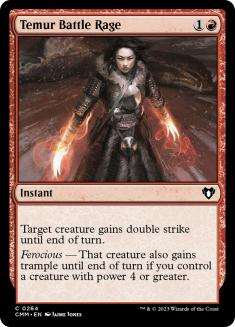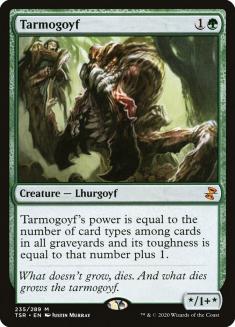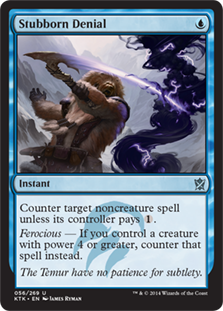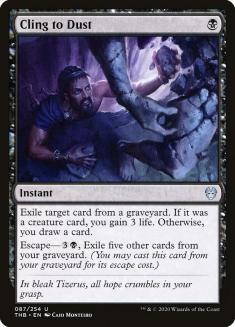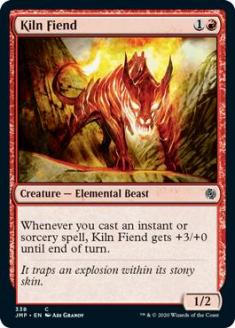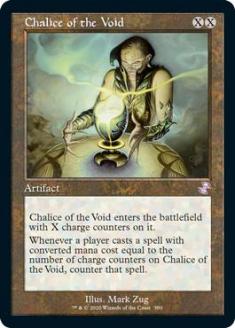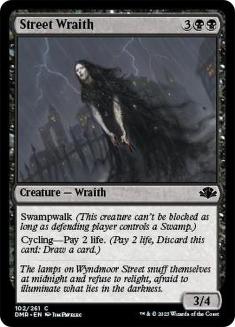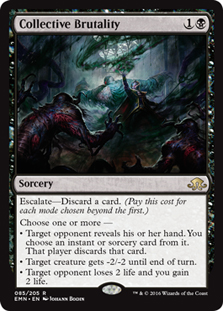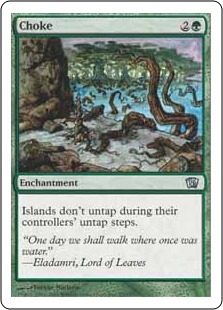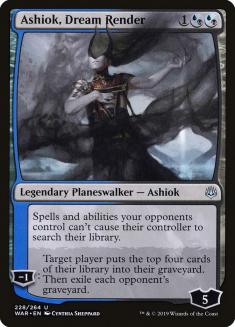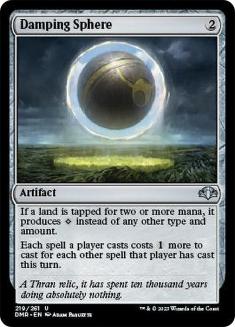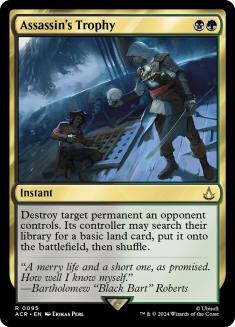Death’s Shadow is one of those cards that I’ve rarely played but always wanted to. For whatever reason, I always found myself on the other side of the matchup, whether with Dredge, Humans, or Izzet Phoenix. But when I think about what Death’s Shadow decks are trying to do, the game plan synergizes well with the types of games I like to play and that I’m good at navigating.
Death’s Shadow is a disruptive deck, but with the ability to turn the corner swiftly. It can bring an opponent from twenty to zero life points in a turn or two while they’re scrambling to rebuild a hand that has been torn apart by discard spells and creature removal. Already we’re getting into territory I like. Disruption plus pressure is always something I’m looking for in a deck.
In order to gain this advantage, these decks sacrifice their own stability. They are threat-light because they need space for all that disruption and can flounder if their first threat or two is answered. Moreover, the nature of Death’s Shadow involves managing a low life total, leaving you in positions where you can lose a game from a good position, especially if you’re not careful.
These disadvantages mean that successful Death’s Shadow pilots have to be comfortable with risk assessment. Sometimes your draw allows you to manage your threats and your life total so you’re always comfortable, and figuring out how to do so is difficult. Other times you are forced into taking calculated risks. Do you go for the win with Temur Battle Rage and lose to a Lightning Bolt? Do you cast your Tarmogoyf on Turn 2 into a possible removal spell or save it until you have a discard spell or Stubborn Denial to protect it?
Answering these questions is tricky business, and knowing when to play safely and when to throw caution to the wind is much of what separates the best Death’s Shadow pilots from the rest. I’m quite comfortable making these judgment calls because of my experience playing combo decks, which involve similar dynamics of both maximizing your cards with proper sequencing and determining when to play around disruption and when to put your cards on the table and cross your fingers.
So after a week of playing Humans, which I wrote about last week, I was looking to change things up and got down to playing some Death’s Shadow. After a weekend of practice, both on and off stream, I woke up Monday morning to a lovely article from our own Ari Lax on the deck:
I’m always excited to see Ari work on a topic that I’m invested in because I find that he and I take similar approaches to the game and value similar things. We’re both highly analytical and work much better when we have a solid understanding of the big picture of the problem at hand, whether in tuning a deck, creating a sideboard plan, or cracking a new metagame. So it was no surprise that I agreed with a large amount of what Ari had to say. But I also disagreed with a lot of it. The good news is that we both agree that the deck is back in Modern’s top tier.
What Ari Got Right
The power of Mystic Sanctuary has allowed blue decks to work towards a powerful end-game, even if they draw too many lands. As a response, we’ve seen Urzatron decks re-emerge to compete with that end-game, as well as blue decks incorporating cards like Scapeshift so they can ignore this arms race and simply end the game.
These adjustments have created a metagame where getting your opponent dead is valuable for any non-blue, non-big mana deck, while also limiting the effectiveness of spot removal. So relative to a traditional midrange deck like Jund, the efficiency and quick transition from defense to offense for Death’s Shadow is valued in the current metagame, while its lower stability is less of a problem. That’s why we’ve seen the card return to prominence.
I also agree with Ari about the superiority of Jund relative to Grixis when it comes to Death’s Shadow variants. And his analysis is spot on when he says “a huge part of this is the London Mulligan.”
So much time in the Magic community is spent talking about the impact of many cards printed in the last year or so. From Teferi, Time Raveler to Oko, Thief of Crowns to Uro, Titan of Nature’s Wrath, we’ve seen a lot of format-defining cards come in 2019 and 2020. But none of these cards have had the impact that the London Mulligan rule has.
Ari covers this well, but to add on, I’d remark that paying mana to fix your draws is not only a bad idea because every deck has access to a powerful means of doing so for free, but also because the time you spend casting those cantrips is punished much more often now.
When Izzet Phoenix was a dominant force in Modern, you would often spend your first two turns casting cantrips, setting up for a powerful Turn 3. Oftentimes, your cheap interaction and the tempo gained from either Thing in the Ice or Arclight Phoenix would be more than enough to compensate, but against your opponent’s best draws you’d fall too far behind.
You took your losses to these draws and moved on, knowing that over a large sample, Izzet Phoenix’s high consistency would win out. That equation fundamentally changed with the London Mulligan, as those top-end draws pop up more and more. Izzet Phoenix gave way to Hogaak, Arisen Necropolis that summer, and the Faithless Looting ban was the nail in the coffin, but I believe the deck would’ve ultimately disappointed had it had a chance to re-emerge in a post-Hogaak world because the London Mulligan undermined its greatest advantage.
Grixis Death’s Shadow suffers a similar decline, and its ability to eke out an incremental advantage with Snapcaster Mage is far less valuable in the current world of Urzatron and Mystic Sanctuary. It’s Tarmogoyf’s time to shine.
What Ari Got Wrong
So I’m with Ari once we get to Tarmogoyf, but that’s when our opinions start to deviate. The rest of his article praises the Prowess-esque lists of Shadow that eschew Street Wraith, play Lurrus of the Dream-Den as a companion, and can end games on Turn 3 with prowess creatures and Mutagenic Growth:
Creatures (14)
Lands (19)
Spells (27)

I actually started out with this list. I like being aggressive and this list was an intriguing balance between the explosiveness of Prowess and disruptive capabilities of Death’s Shadow. But ultimately I came away unimpressed with the Prowess elements of the deck.
Firstly, Monastery Swiftspear and Soul-Scar Mage were awkward fits, especially the discard spells. You want to lead on discard to disrupt the opponent, but doing so means you lose out on Prowess triggers. If you save the discard to maximize your damage output, then you might miss a key spell.
But the problems don’t end there. From a big-picture perspective, discard spells restrict the resources available in a given game. They pair well with threats like Tarmogoyf and Dark Confidant because those cards play very well on their own and can dominate a game with little help. This isn’t the case for Monastery Swiftspear, which needs a steady stream of spells to trigger Prowess or it quickly morphs into a glorified Norwood Ranger. When you’re casting Thoughtseize and Inquisition of Kozilek, that stream dries up quickly.
Cling to Dust is a big help here, offering a great cantrip that can be escaped later on, and Ari is right to single it out as an important card in the deck. But you can still play Cling in a typical list and it’s not enough to overcome the anti-synergy Monastery Swiftspear and Soul-Scar Mage have with the deck.
Now to be fair, Ari says he’s not married to those creatures, but instead praises Kiln Fiend as a standout performer. Kiln Fiend has the same sequencing and strategic issues as the one-drops while being more of a liability against cheap removal and not triggering off Mishra’s Bauble, which because of Lurrus is more of an issue than you might think.
Lastly, trying to build around these threats to have a faster goldfish kill runs you headfirst into one of the most problematic cards for this deck: Chalice of the Void.
Eldrazi Tron is one of the format’s most popular decks so you run into Chalice quite a bit, and it’s nigh unbeatable when your opponent casts it on Turn 2 unless you remove it from the battlefield. But the cards which do so – Assassin’s Trophy, Abrupt Decay, Abrade, Kolaghan’s Command, etc. – are all hard to justify in the maindeck of a deck trying to play prowess threats.
Moreover, trying to slim the curve down to accommodate those creatures means playing more one-mana cards, thus increasing your vulnerability to Chalice of the Void. Essentially, these creatures incentivize you to play weaker cards in order to maximize their efficacy, and that trade-off isn’t worthwhile.
In Defense of Street Wraith
The other reason Ari gravitated toward this list is that it eschews Street Wraith in favor of using Lurrus as a companion. In his words, “Street Wraith is hot garbage in 2020.”
And while I agree with him when he says the London Mulligan exacerbates the issues Street Wraith presents when making mulligan decisions, I still think the card is worthwhile and actually quite important to the functioning of the deck.
Without Street Wraith, it’s too hard to cast an early Death’s Shadow. The Prowess-esque lists have Mutagenic Growth as another source of life loss, but that requires you to have another threat on the battlefield and attacking or you’re at best throwing away a card. In a deck that doesn’t have a ton of creatures, this is no small condition to meet.
Death’s Shadow is your best threat. It’s the reason this deck exists. And the games where you cast it on Turn 2 or 3 are your best draws because it provides a great clock with a very low mana investment. Fetchlands, shocklands, and Street Wraith cost you nothing to lose life, while Thoughtseize provides life loss with disruption. Mutagenic Growth may look free, but it comes with hidden costs, strings attached.
I was impressed by having Lurrus as a companion, but was happy to see that playing it as a Traverse the Ulvenwald target isn’t much of a drop-off, and it’s a fine card to draw naturally. If that delta were larger, then it might be a conversation, but it isn’t.
Lastly, eschewing Street Wrath means you’re more reliant on drawing early fetchlands to lose life, so you have to play more. The list Ari recommends only plays one copy of Nurturing Peatland as a result, and given how powerful Horizon lands are, that’s a significant cost. With cantrips like Street Wraith, Cling to Dust, and Mishra’s Bauble that don’t come with extra deck manipulation, you are at risk of flooding even with a low land count. Horizon lands go a long way toward mitigating that risk while also playing well with Death’s Shadow, letting you manage your life total down to an exact point before turning into a fresh card.
It’s true that the prowess-based list has more explosive draws, and those draws are valuable against big mana and other low-interaction strategies, but if you’re looking to do something like that, just play Prowess and splash for Tarmogoyf if you really want to.
My Recommended List
Creatures (14)
Lands (18)
Spells (28)

I started with Dylan Hovey’s list from the Top 8 of the last Modern Challenge, and I haven’t felt the need to deviate much. Dylan is no stranger to Death’s Shadow and his list is built with a sleek, efficient maindeck and a ton of high-impact sideboard cards for popular matchups.
My first deviation from his list is fitting a couple of copies of Cling to Dust in the maindeck because the card is so important for disrupting Uro, Titan of Nature’s Wrath and Mystic Sanctuary. I trimmed down to seven discard spells and moved one of the Nihil Spellbombs to the sideboard.
In the sideboard, my main observation was that Collective Brutality sucks. It’s great against Burn but not against Prowess, since they can grow their creatures out of its range and are more capable of recovering from the early resource trade. There are very few Collected Company decks around for it to target, and its applications against control and combo decks, which were already limited, are made much worse by the presence of Veil of Summer.
Seriously, I’ve had my Brutality Veiled twice by Scapeshift, and after the second I contemplated retirement.
With Brutality out, I’m a bit light against non-tribal aggro, where Wrenn and Six and Plague Engineer shine. The extra Fatal Push helps, as against Prowess it’s important to have a pile of cheap removal, and Push pulls double duty in the Shadow mirrors. But it’s a liability against the newly popular Stormwing Entity, so the list could easily move in that direction in the coming days.
But skimping on the aggro-hate lets you play some excellent haymakers in Choke against blue decks; Ashiok, Dream Render against Scapeshift and Primeval Titan decks; and Damping Sphere against Mono-Green Tron and Gifts Storm. These are all cards that can win a game by themselves and are thus worthy of inclusion.
The rest of the sideboard contains cards that help in attrition mirrors. Wrenn and Six is a real threat there in combination with Nurturing Peatland, and having a couple of ways to recur key threats in Kolaghan’s Command and Unearth is valuable in any matchup where you’re trading creatures and removal.
Lastly I’ve chosen to include a third copy of Assassin’s Trophy because there’s a wide variety of applications for the card in the current metagame. I’ve targeted Chalice of the Void; Blood Moon; Glorybringer; Ugin, the Ineffable; Stormwing Entity; Wrenn and Six; and even a Mystic Sanctuary that was targeted with a Cryptic Command with the card. And yes, the other mode of that Cryptic Command was to tap my lethal creatures. Post-sideboard games involve a lot more must-answer threats and they tend to go longer, mitigating the card’s downside.
The last question is whether or not to splash blue and play Stubborn Denial. I’ll admit that I’m not experienced enough to be confident which is better, and I can see the merits of the card. But for now I’m happy with the disruption this deck has and will always err on the side of more consistent mana. Maybe the London Mulligan rule has made my consistency concerns overblown, but regardless of how many hands you see, it’s hard to have four colors of mana on two lands and still cast all your green and black spells on curve.
Modern is changing a lot right now because no one really knows what the best deck or decks are. There are several powerful cores to build around and plenty of variations on how to build around them, so disagreement like you see between Ari and me is going to be common. I’m looking forward to seeing how things shake out in the coming weeks, just in time for Zendikar Rising to change it all again.


